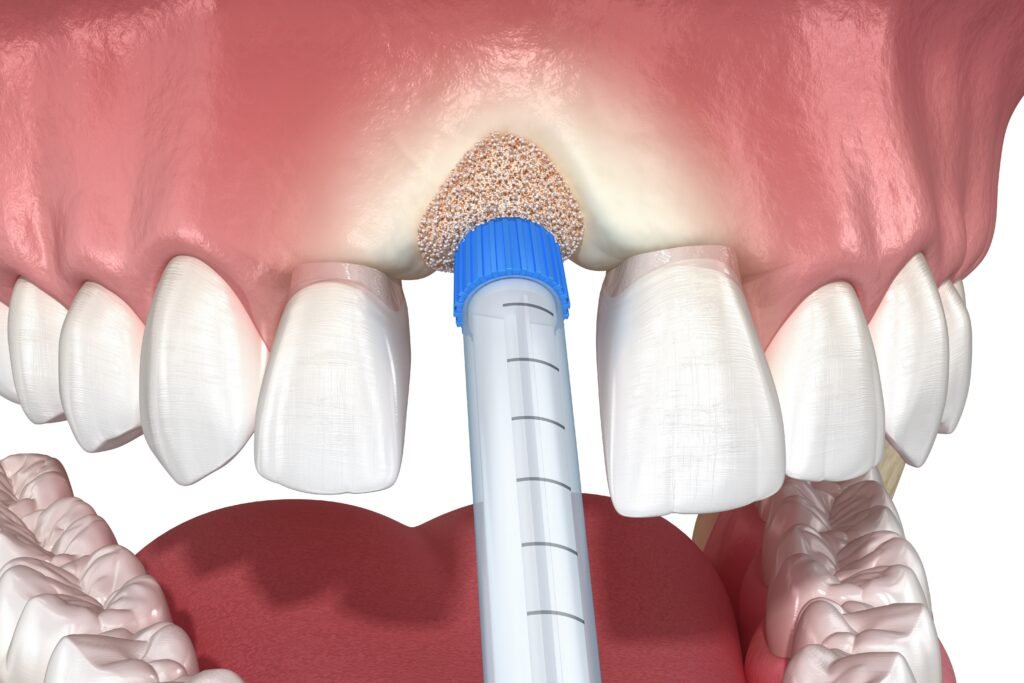Welcome to the Little Smiles of Beverly Hills blog, your trusted resource for understanding dental health and the innovative treatments that restore your smile right here in Beverly Hills. When you consider a dental implant in Beverly Hills, you may encounter the term “bone graft.” This guide will walk you through everything you need to know about a bone graft for your dental implant, from its purpose to how it paves the way for a successful, beautiful smile in Beverly Hills. The team at Little Smiles of Beverly Hills is here to help you understand every step of the bone graft process.

What Is a Bone Graft and Why Do You Need It
Think of a dental implant as a skyscraper. Just as a skyscraper needs a deep, stable foundation to withstand time and pressure, a dental implant needs a strong, dense jawbone to anchor it securely. The dental implant post, typically made of titanium, fuses with your jawbone through a process called osseointegration. Without sufficient bone volume and density, this fusion cannot happen, and the dental implant is at risk of failure. This is why a bone graft is often a necessary first step for a successful dental implant in Beverly Hills.
Bone loss in the jaw is a common issue that occurs for several reasons, and a bone graft offers a solution. It is a surgical procedure that addresses these issues by rebuilding and augmenting the jawbone. It involves transplanting bone or a bone-like material to the deficient area, providing a scaffold upon which new, healthy bone can grow. This regenerative process creates the solid foundation necessary for a successful dental implant in Beverly Hills. A proper bone graft is key to a long-lasting dental implant. The bone graft procedure our Beverly Hills team performs is precise and effective.
Types of Bone Grafts: Finding the Right Material for Your Foundation
The success of a bone graft procedure hinges on the material used. There are several types of bone graft options, each with its unique source and advantages. Your dental professional here in Beverly Hills chooses the bone graft material based on your specific needs and the extent of the bone loss. Ultimately, every bone graft aims to provide a solid base for a future dental implant. A successful bone graft is the bedrock of a beautiful smile.
Table 1: Common Types of Bone Grafts
| Type of Bone Graft | Source | Advantages |
| Autograft | Patient’s own body (e.g., jaw, chin) | Gold Standard, contains living cells, zero risk of rejection. |
| Allograft | Human donor (cadaver) | Avoids a second surgical site, serves as a scaffold for new bone. |
| Xenograft | Animal (e.g., cow) | Readily available, avoids a second surgical site, provides a stable scaffold. |
| Alloplast | Synthetic (e.g., calcium phosphate) | Sterile, no risk of disease transmission, avoids a second surgical site. |
The Bone Grafting Procedure, What to Expect Step by Step
Your journey to a restored smile begins with a thorough consultation, and a detailed treatment plan right here in Beverly Hills. Your periodontist at Little Smiles of Beverly Hills uses diagnostic tools like X-rays and 3D CT scans to assess your jawbone and determine the precise location and size of the bone graft. A successful bone graft procedure is meticulously planned.
The bone graft procedure itself is typically an outpatient surgery and our specialists in Beverly Hills perform it with your comfort in mind. Here is a general overview of what to expect during your bone graft procedure:
- Anesthesia: A local anesthetic numbs the surgical site for your bone graft, ensuring a pain-free experience.
- Incision and Preparation: Your surgeon makes a small incision in your gum tissue to gently expose the underlying jawbone for the bone graft.
- Graft Placement: The surgeon carefully places the chosen bone graft material in the area of bone deficiency. In some cases, they place a protective membrane over the bone graft.
- Suturing: The surgeon repositions the gum tissue and closes the incision with sutures. This is the final step of the bone graft procedure.
The entire bone graft procedure can take anywhere from 45 to 90 minutes.
A Smooth Recovery, Your Path to a Stronger Smile
While the bone graft surgical procedure is relatively quick, the healing process is the most critical part of a successful bone graft. Your body needs time to integrate the new material and regenerate its own bone tissue.
Table 2: Bone Graft Recovery Timeline
| Phase | Duration | Key Post-Op Care |
| Immediate Recovery | First few days | Apply ice packs, take prescribed medication, eat a soft diet, practice gentle oral hygiene. |
| Intermediate Healing | 1 to 4 weeks | Swelling and bruising subside. Continue with a soft-to-regular diet as tolerated. |
| Full Integration | 3 to 12 months | The new bone graft fully integrates with the existing jawbone, creating a stable foundation for your dental implant. |
The Long-Term Benefits of Bone Grafting
While it requires patience, the benefits of a bone graft are immeasurable. It’s not just about enabling a dental implant, it’s about a long-term investment in your oral health and overall well-being. A successful bone graft for a dental implant is an investment that pays off.
- Foundation for Success: A bone graft dramatically increases the success rate of a dental implant, ensuring your new smile is stable, durable, and lasts a lifetime.
- Restored Functionality: A solid foundation from a bone graft allows you to chew, bite, and speak with confidence, restoring the full functionality of your mouth.
- Improved Aesthetics: By rebuilding the jawbone with a bone graft, you can help maintain the natural contours of your face.
Frequently Asked Questions
The bone graft is performed under local anesthesia in Beverly Hills, so you won’t feel any pain during the surgery.
While initial recovery is a few days, the full healing and integration of the bone graft can take anywhere from 3 to 12 months.
In some cases of minor bone loss, yes. However, for more significant bone deficiencies, the bone graft needs to heal completely before you can place the dental implant.
Without a bone graft, a dental implant cannot be placed in an area with insufficient bone density.
The risks of a bone graft are minimal and similar to any oral surgery.
The cost of a bone graft for a dental implant varies widely. Our Beverly Hills office can provide a detailed quote.
The risk of rejection is extremely low for a bone graft.
While rare, a bone graft can fail. Following your Beverly Hills surgeon’s instructions is crucial.
A bone graft for a dental implant has a very high success rate in Beverly Hills.
Anyone in Beverly Hills with insufficient jawbone volume for a dental implant is a candidate for a bone graft.
Your First Step Toward a New Smile
A bone graft is a vital and transformative procedure that lays the groundwork for a successful dental implant. It is a testament to modern dentistry’s ability to not only replace missing teeth but also to restore the underlying structure that supports a healthy, vibrant smile. At Little Smiles of Beverly Hills, our team is committed to guiding you through every step of this journey with the highest level of expertise and care. To learn more about our services, please visit our services page. If you’d like to read more about our dedicated team and our philosophy, our about us section is available for you. We understand that a successful dental implant is built on a strong foundation, and we are here to ensure yours is solid for years to come. To take the next step, we encourage you to contact us today and schedule a consultation with a top specialist in Beverly Hills. For general information on dental procedures, you can also visit a trusted source like the American Dental Association.



